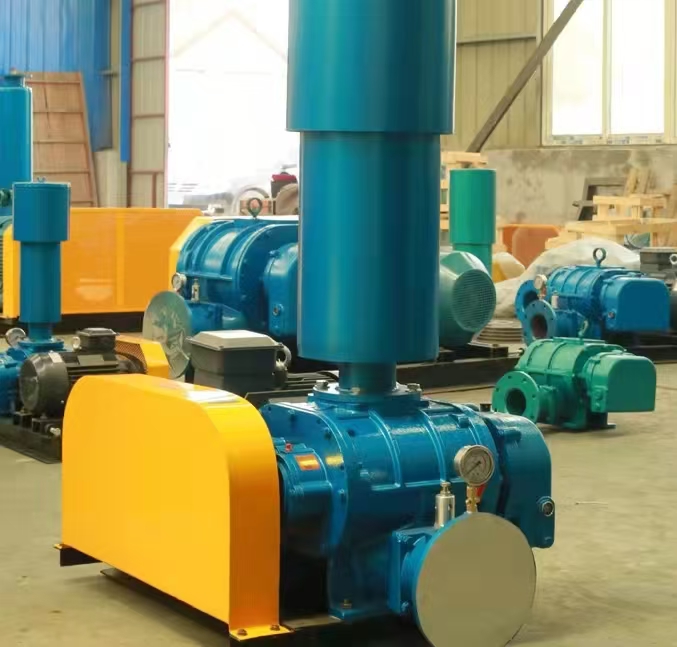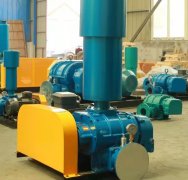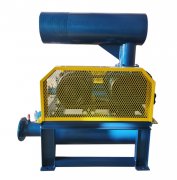**Reasons and solutions for the decrease in air volume of Roots blower**
The decrease in the air volume of the Roots blower will directly affect the operational efficiency of systems such as fish pond oxygenation and sewage treatment. The following are common causes and corresponding troubleshooting and solutions to help quickly restore fan performance.
---

**1、 Main cause analysis**
|* * Fault Category * * | * * Specific Reason * * | * * Impact Description * *|
|--------------------|---------------------------|-----------------------------|
|* * Air intake issue * * | 1 Air filter blockage | Increased intake resistance, decreased air volume|
| | 2. Air leakage/blockage in the intake duct | reduction in effective intake volume|
|* * Mechanical malfunction * * | 3 Belt slippage or breakage | Insufficient speed, decreased air volume|
| | 4. Impeller wear or excessive clearance | Increased internal leakage, reduced efficiency|
| | 5. Bearing/gear damage | Increased transmission resistance, abnormal speed|
|* * System resistance issue * * | 6 Blockage of exhaust duct | Increased back pressure, limited air volume|
| | 7. Aeration head/microporous tube blockage | Common in fish pond oxygenation system|
|* * Electrical issues * * | 8 Insufficient motor voltage or abnormal frequency | Decreased speed and reduced air volume|
|* * Environmental factors * * | 9 Excessive intake temperature or altitude impact | Changes in air density, resulting in a decrease in actual air volume|
---
**2、 Detailed investigation and solution methods**
**1. Check the intake system**
-Phenomenon: The fan is running with normal current, but the exhaust pressure is insufficient.
-* * Solution steps * *:
1. * * Clean/replace air filter * *: Remove the filter and observe if it is clogged with dust or algae (fish pond environment is prone to clogging).
2. * * Check the intake duct * *: Ensure that the duct is not folded or leaking (listen for a leak sound or use soapy water to detect it).
3. Environmental temperature impact: During high temperature weather, the intake density decreases, and it is necessary to increase the speed compensation appropriately.
**2. Mechanical maintenance**
-Phenomenon: Abnormal noise, vibration, or speed of the fan.
-* * Solution steps * *:
1. Belt driven type:
-Check if the belt is loose or worn (the depression at the midpoint should be 5-10mm).
-Replace broken or aged belts (need to be replaced in groups to avoid mixing old and new).
2. Impeller and clearance:
-After stopping the machine, manually rotate the impeller to check for any jamming or friction.
-Measure the clearance between the impeller with a feeler gauge (standard 0.2~0.4mm), and adjust or replace the impeller if it exceeds the tolerance.
3. * * Bearings/Gears * *:
-Listen for any abnormal noise from the bearings (metal friction sound) and replace damaged bearings (such as SKF 6205).
-Check the oil level and quality of the gearbox, and replace the oil if there are too many impurities (ISO VG220).
**3. Check the resistance of the exhaust system**
-Phenomenon: The pressure gauge shows high back pressure and the motor current increases.
-* * Solution steps * *:
1. Fish pond oxygenation system:
-Check if the aeration tube and nanotubes are blocked by sludge or algae (remove the aeration head and rinse).
-Reassign the layout of aeration pipes to avoid excessive local resistance.
2. * * Industrial piping system * *:
-Check if the valve is not open or if there is dust accumulation in the pipeline (stop the machine for cleaning).
**4. Electrical problem investigation**
-Phenomenon: The motor speed significantly decreases and the air volume drops sharply.
-* * Solution steps * *:
1. Measure the voltage with a multimeter (380V ± 10 is normal).
2. Check if the output frequency of the frequency converter (if any) is set correctly (50Hz is the standard).
**5. Other factors**
-Altitude impact: In high-altitude areas where the air is thin, it is necessary to choose a larger model or boost compensation.
-Long term lack of maintenance: Carbon or oil deposits inside the fan cause a decrease in efficiency and require disassembly and cleaning.
---
**3、 Preventive measures**
1. * * Regular Maintenance Plan * *:
-Clean the intake filter element weekly and check the belt/gear oil monthly.
-Inspect the impeller clearance and bearing condition annually.
2. * * Install monitoring equipment * *:
-Install pressure gauges and ammeters to monitor the status of the fan in real-time.
3. * * Spare Parts * *:
-Always keep vulnerable parts such as belts and filter cartridges to avoid sudden shutdowns.
---
**Summary**
-Quick troubleshooting sequence: intake filter → belt → aeration tube → impeller clearance → electrical.
-* * Key points for oxygenation in fish ponds * *: The decrease in 80% air volume is caused by * * blockage of the aeration tube * * or * * dirty filter element * *. Prioritize checking these two items!
-* * Complex faults * *: such as impeller wear or bearing damage, it is recommended to contact professional maintenance personnel for handling.
If the problem is still not resolved, please provide * * fan model, usage scenario, and specific phenomena * *, and I will help you further analyze!



